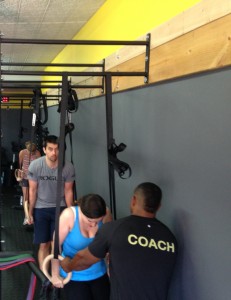WARNING: This article may be offensive to some coaches. The intent, however, is to express what I see as a need for a more comprehensive understanding of why coaches need to study more than CrossFit.
A coach’s knowledge base should be formed on a diversity of knowledge, training, and experience. While a single certification, from a single source, is beneficial as a baseline level of knowledge, the broader a coach’s knowledge base, the more fruitful the athlete’s overall CrossFit experience. While CrossFit has expanded its certification offerings in order to develop a more well-rounded coach, the bottom line is that CrossFit certifications should not solely form a coach’s knowledge base.
As an athlete and CrossFit Level 1 Trainer, I will be the first to admit that all CrossFit coaches are not created equal. As a result of having taken an affirmative vested interest in my member’s overall fitness development, I realize that it is incumbent a coach to truly examine what exactly you are telling the member, and how exactly are you qualified to teach you what you are saying. Additionally you must evaluate whether you are merely Googling workouts for members to do, and watching videos to get instruction points from an internet article or video, or do you have the necessary knowledge base to build a comprehensive program, execute that program, and the ability to explain what all of this madness means to a client as an individual athlete.

If you can’t answer the why behind every movement; every workout; every stretch; every dietary recommendation, then WHY are you coaching? Your athletes deserve more.
With a novice athlete, the tricky part is that, on the surface, anyone can talk a good game and sound like they are more knowledgeable than what they actually are. It is extremely easy to say vastus lateralis, instead of simply saying quad, in an attempt to give the perception that a coach knows the kinetic movements associated with a particular body part. It’s easy to take a workout from CrossFit New England, or CrossFit Invictus, but if you don’t understand the underlying programming rationale behind it, what happens when your member asks. . . . ”WHY?”
This same extends past just the workout. Would you allow your doctor to simply give you an injection, or would you ask her why she is doing it? What if the member asks: “Hey Coach, what is this stretch doing for me?”; “Why do I need it to do that ?”; “What effects will this have on my long term goals?”; “What underlying deficiency will this correct?”; and “How are you even qualified to provide me with this advice.” These are not boilerplate questions, nor are the answers. Instead, this is demonstrative of the significance of knowing the why rationale behind everything you do. In other words, the bottom line rabbit hole that every coach should be prepared to go down. This is the ultimate test of your knowledge, and application thereof. A member has every right to ask you why, and what makes you qualified to instruct her on anything from the basic movements utilized by CrossFit, to providing them with comprehensive nutritional advice. This premise should not be offensive to you, and you should be able to answer these hard questions prior to training clients. Simply saying that “I learned this at my CrossFit Certification; because Rich Froning does it; or to prepare you for the unknown and unknowable,” are not the right answers. Members deserve a fruitful logical science based rationale for why they are doing something, as well as the overall methodology behind your programming and programming philosophy (if in fact you have one at all).
This understanding of the interaction of various components of fitness, is best obtained through both structured and independent study in a variety of disciplines, as well as obtaining practical knowledge related to this studies. Novice athletes often confuse CrossFit with the independent fitness modalities from which CrossFit was derived. CrossFit did not “invent” any of the movements which encompass the individual components. The snatch and clean and jerk have been performed by Olympic Lifters and Strength and Conditioning coaches for decades; gymnast have been using bodyweight training such as pull ups, dips, pushups, and handstand movements as a means to develop overall strength since the times of the ancient Greeks; strength and conditioning coaches have been doing presses, deadlifts, and squats as a means to build overall strength for years; and the military has used functional team building training and exercise modalities to build community since inception. What CrossFit does, however, is encompasses a fitness regime which takes the best of this individual components, and provides a mechanism through which to deliver them succinctly. What a coach must understand is that these individual components must be studied in order to provide the coach, and more importantly the athlete, with the theoretical and practical framework necessary to teach movements safely and efficiently. A CrossFit coach who does not grasp this concept, and is not willing to put in the time necessary to accomplish this, should not be coaching members, and is not worth the paper his Level 1 Training Certificate is printed on.

A Coach must have more than just a superficial understanding of the interrelated disciplines that encompass CrossFit
Along similar lines, CrossFit training is not enough. While CrossFit certs are excellent at giving a baseline understanding of movements and the interplay between those movements and the human body, they are still a Cliff Note version of the science behind the movement. When Coach Greg Glassman, the founder of CrossFit, decided that the divergent views of fitness at the time lead to, well, a lack of fitness, he began an independent study which built upon his already existing knowledge base. He dug into the resources that were available for the separate disciplines; sorted through and took out the relevant scientifically proven components; and combined them into what we know as CrossFit. The important piece here is that he studied to learn how to best coach human performance and movement, and never merely relied on anyone else’s word. This made him readily adapt at answering the “Why?” behind everything to his small contingent at the time, as well as to the naysayers who came along as a result of CrossFit’s success. Although CrossFit has evolved since those early days, I am sure that Coach Glassman would agree, a broadened exposure to multiple knowledge bases is absolutely necessary for the mental acumen of a CrossFit coach.
As stated earlier, CrossFit has developed a comprehensive training program which is geared toward expanding this essential knowledge base, as well as increasing the coaching expertise in the CrossFit community. But these too must be supplemented with a foundation rich in academic or independent study in exercise physiology, classic strength and conditioning, gymnastics, running and endurance, or whichever other individual component is relevant to a particular exercise methodology practiced at your CrossFit affiliate. In fact, the broad modalities of CrossFit make it a necessity that these individual versions of movements be studied in depth. A diverse course of study consisting of a combination of some, or all, components of institutionalized, structured seminar/certification, and independent or practical training/study and experience, makes for a better CrossFit knowledge base. Further, and arguably of highest concern, a coach must have the practical and cognitive ability to be able to fully relay that information to an athlete in an easily digestible manner, as well as the ability to fully understand and appreciate that the coaches lack of knowledge, training, and experience will eventually lead to injury.
The bottom line is that a CrossFit gym is more than posting pictures and videos on Facebook; standing in awe at the shiny new equipment you have purchased; or screaming at members to “Go, Go, Go.” A coach should realize that the best CrossFit coaching experience can be obtained in a garage, with a small group of people, with a coach with the knowledge, training and experience to help members achieve their goals, just as it can be achieved in a 10,000 square foot facility with Regional and Games level athletes. The athlete’s decision to trust you with their health, and sometimes livelihood, should be based upon an informed decision that you are qualified and knowledgeable to do what you are doing. Athletes at CrossFit gyms pay an increasingly large sum of money to be properly trained. They deserve the best experience, while under the watchful eyes of coaches who possess all of the tools necessary to make their experience injury free and productive. Otherwise, the “coach” is nothing more than a cheerleader yelling “Yes you did it! Good job.”
Don’t be afraid of the client who asks “Why?” Have the structured discipline to actually study, and improve yourself intellectually for the immense amount of trust your client places in you. Anything less is a disservice to your members.
By the way. If you missed Part One of this series you can find it by clicking here.
CrossFit Prelude. “The Beginning of Something Better.” What is Your Something?
